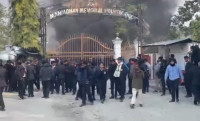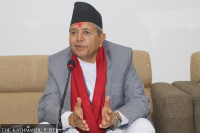National
No light at the end of the tunnel: Substation dispute at Lapsephedi drags on
An electricity authority official says that the committee formed to address the problems through consultation has failed to prepare its work procedure for itself to move forward.
Prithvi Man Shrestha
The dispute regarding the proposed transmission substation at Lapsephedi in Shankarapur Municipality-3 on the outskirts of Kathmandu continues to remain unresolved with the committee formed to address the issue failing to make any headway towards a solution.
Nepal Electricity Authority and the local people are at loggerheads over the power utility’s plan to construct the substation for the 400kV Naya Khimti-Barhabise-Lapsephedi transmission line, which it says is vital for meeting the growing power demand in Kathmandu Valley. The dispute has made the project uncertain.
On January 14, two sides had reached a three-point agreement, under which the locals agreed to halt the ongoing obstruction while the local administration would withdraw the police mobilised there, according to the NEA. Likewise, a coordination committee was formed headed by ward-7 chairperson Bishnu Prasad Shrestha to discuss with the locals the positive and negative impacts of the transmission line projects, and the demands of the locals.
The committee includes Krishna Chandra Poudel, undersecretary at the Area Administration Office, Sankhu, Surya Bahadur Tamang, ward 3 chairperson, Ranjit Tamang, president of Tamang Sarokar Samaj, and locals Phurba Lama and Pawan Waiba as members. The committee was supposed to submit its report within five days after interacting with the locals, according to the NEA.
Tara Prasad Pradhan, deputy managing director of NEA, said that the committee mandated to formulate its work procedure has failed even to prepare the rules, let alone solve the problem. “It is because most of the local members on the committee are not participating in the talks,” Pradhan said. “Even those who participated including ward-3 chairperson Tamang are not marking their attendance.”
Despite NEA’s claims, representatives of the Local Struggle Committee didn’t own up the agreement. “Local Struggle Committee considered the claimed agreement as a conspiracy and decided not to participate in the meeting of the committee,” said ward 3 chair Tamang. “With them not participating in the meeting, formation of the committee has been insignificant.”
According to him, the locals have a one-point demand that the substation should be relocated.
With representatives of agitating locals not participating in the meeting, the committee has failed to prepare the procedure for settling the dispute. “Without the working procedure, there has been no talk towards finding a solution to the problem,” Pradhan said.
In a statement on January 14, the NEA claimed that the power monopoly will suspend drilling and survey works being undertaken at the proposed location for five days.
Pradhan said that the NEA would give talks another chance. “We will also discuss with our top management on how to move forward now and we may have to discuss with the lawmakers and other political leaders on solving the matter,” he said.
A group of local residents has been demanding the relocation of the proposed substation and it appears that there is general consensus on the matter among the local political leaders.
That’s why Shankarapur Municipality itself in its budget and programme unveiled for the current fiscal year (2022-23) has vowed to make efforts to relocate the proposed substation.
“As the substation and the Tamakoshi transmission line will affect the settlement of indigenous nationalities, a request will be made to go ahead with relocating the substation,” the local unit’s budget and programme 2022-23 states.
However, the state-owned power distributor insists there is no better place than the current location to build the substation. The NEA has also alleged politicisation of the issue for the stalemate with the locals though the land was acquired long ago by the NEA and all beneficiaries except one have received the compensation. “When we acquired the land, it was an open space without any settlements. There are still not many houses around,” said Pradhan.
But agitating locals say that the substation is being built on a human settlement which is unacceptable to them.
Earlier, various non-government organisations also expressed their solidarity with the locals. The Struggle Against Marginalisation of Nationalities and Nepal Tamang Ghedung protested against substation plans, reminding them that evicting indigenous people from their locality would be against international conventions that Nepal is a party to.
However, Pradhan said that the settlements could not be fully avoided while constructing a straight transmission line.
Due to locals’ obstructions, the future of the 400kV Naya Khimti-Barhabise-Lapsephedi transmission line has become uncertain.
According to the NEA, the project is in its final phase of completion with just one substation at Bojhini and four transmission towers being the only remaining tasks to be completed before the transmission of electricity starts through this power line.
The NEA claims that protesters were instigated by other unrelated people even after the locals whose lands were acquired received the compensation. Due to a delay in completing the construction of this high-capacity power line, the NEA has failed to bring the power generated from the country’s largest 456MW Upper Tamakoshi Project directly to the Kathmandu Valley. After the Upper Tamakoshi came into commercial operation in August 2021, its power has been taken to Dhalkebar from where electricity is being transmitted to the eastern region as well as Kathmandu. According to Dirghayu Kumar Shrestha, chief of the Transmission Directorate, the NEA has incurred higher power leakages because of the long distance the transmission line covers.
Obstruction at Lapsiphedi is the latest example of how difficult it has been to construct the transmission line in Nepal though the country is in a higher need to build them to transmit growing power production in the country. Nepal not only aims to increase domestic consumption but also to export power in large volumes in the days to come.




 7.12°C Kathmandu
7.12°C Kathmandu















